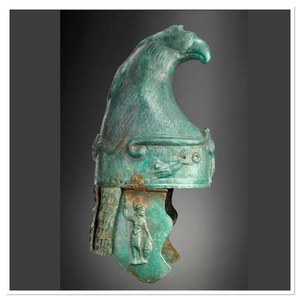Phrygia was a kingdom in central Anatolia from around 1200 to 700BC. They were Indo-Europeans that migrated from the Balkans and caused the fall of the mighty Hittite Empire. They worshipped the goddess Cybele who was called “Mother Mountain”. Her priesthood was made up of eunuchs who willfully castrated themselves in service of the goddess and in consolidation with the castrated Attis, her consort. “By the 4th century BC (early Hellenistic period) the Phrygian cap was associated with Phrygian Attis, the cult of which had by then become graecified. At around the same time, the cap appears in depictions of the legendary king Midas and other Phrygians in Greek vase-paintings and sculpture. Such images predate the earliest surviving literary references to the cap. The Phrygian cap came to be applied to several other non-Greek-speaking peoples , most notable of these extended senses of "Phrygian" were the Trojans and other western Anatolian peoples, who in Greek perception were synonymous with the Phrygians. Other Greek earthenware of antiquity also depict Amazons and Scythian archers with Phrygian caps.” “ As described by Herodotus, the name of the Scythian tribe of the tigrakhauda (Orthocorybantians) is a bahuvrihi compound literally translating to "people with pointed hats".
Maybe because of honouring Attis after his castration, the Phrygian cap came to resemble manhood or the phallus. Through the Indo-European tradtions it was transferred all over Europe and Asia. For example: “Originating from the Japanese Heian period, the kazaori eboshi was worn by aristocrats to indicate rank. Still worn today for ceremonial purposes, this black linen hat was used during a samurai's ceremony in attaining manhood. Phallic worship and gods are nothing new in antiquity. Every culture has had phallic worship and in some parts of the world this custom still continues. One great example of this is in Iran at the Khalid Nabi Cemetary. “In popular media the stones are often described as examples of phallic architecture and a major tourist attraction. Touristic visitors often have perceived the cylindrical shafts with the thicker top as depictions of male phalli. This gave rise to popular guesses about pre-Islamic fertility cults as background to such perceived depictions”.
Interestingly the gallbladder is also called the Phrygian cap due to its shape similarity to the hat and gallstones or removal of the gallbladder can cause erectile dysfunction in males, again indicating the link between the hat and the phallus. Our ancient forefathers were much more in touch with the human body and how to cure it, and they often wore headgear that resembled important glands, etc. as can be seen by the Egyptian gods. Thus worshippers of Cybele wearing the Phrygian caps were honouring the goddess, the gallbladder and the phallus as fertility symbols.
The Golden hats are a very specific and rare type of archaeological artifact from Bronze Age Europe. It is assumed that the Golden Hats served as religious insignia for the deities or priests of a sun cult then widespread in Central Europe. Their use as head-gear is strongly supported by the fact that the three of four examples have a cap-like widening at the bottom of the cone, and that their openings are oval (not round), with diameters and shapes roughly equivalent to those of a human skull. The four hats found so far are:
- Golden Hat of Schifferstadt, found in 1835 at Schifferstadt near Speyer, c. 1400–1300 BC.
- Avanton Gold Cone, incomplete, found at Avanton near Poitiers in 1844, c. 1000–900 BC.
- Golden Cone of Ezelsdorf-Buch, found near Ezelsdorf near Nuremberg in 1953, c. 1000–900 BC; the tallest known specimen at c. 90 cm.
- Berlin Gold Hat, found probably in Swabia or Switzerland, c. 1000–800 BC; acquired by the Museum für Vor- und Frühgeschichte, Berlin, in 1996.
The Papal tiara in the Middle Ages is sometimes shown as more pointed than in more recent centuries, though also shown with no point. Popular among Burgundian noblewomen in the 15th century was a type of conical headgear now called a hennin. The whirling dervishes from the 13th century wore hats similar to the hennins, and the Ottoman Janissaries wore similar headgear to show their veneration for Hadji Bektash, founder of a Sufi order. Conical hats were also popular in late medieval Vijayanagar, India.
Medieval Jewish men wore distinctive headgear as required by European Christian authorities. This included the pointed Jewish hat (or "Judenhut") already worn by Jews, a piece of clothing probably imported from the Islamic world and perhaps before that from Persia. The shape of the hat is variable. Sometimes, especially in the 13th century, it is a soft Phrygian cap, but rather more common in the early period is a hat with a round circular brim—apparently stiff—curving round to a tapering top that ends in a point. In Europe, the Jewish hat was worn in France from the 11th century, and Italy from the 12th, presumably arriving from the Islamic world. Under Jewish law, observant Jews should keep their heads covered almost all the time and the Christian authorities made this law later on, to distinguish not only who the Jews are but also the Saracens.
Apart from hats that symbolized phalli (even though it may have lost this specific meaning over time), there are also many architectural examples, such as minarets, obelisks and niches/mihrab. These symbols are present in many Persian carpets with the niche design.



